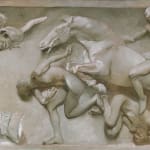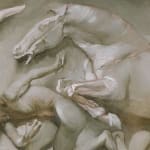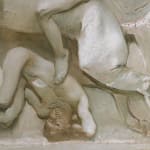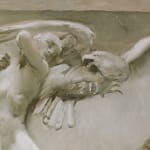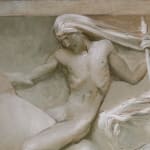




GIULIO ARISTIDE SARTORIO ROME, 1860 -1932
SOLD
MUSÉE D'ORSAY, PARIS
Further images
Provenance
Marga Sartorio collection, Rome; Private collection, Rome
Exhibitions
Sala del Lazio, Esposizione Internazionale del Sempione, Milano, 1906; Crociera Regia Nave Italia 1924; G. A. Sartorio, Galleria del Levante, Milano, 1974; Un fregio di Giulio Aristide Sartorio, Roma, Galleria dell’Emporio Floreale, 1974; Giulio Aristide Sartorio. Figura e decorazione, Roma, Palazzo Montecitorio, Sala della Regina, 1989.
Literature
Esposizione di Milano 1906, Mostra Nazionale di Belle Arti, catalogo illustrato, Milano p. 39;
Dalla caduta di Roma imperiale alle conquiste ultime della scienza. Fregio decorativo di G. A. Sartorio, Danesi editore, Roma 1906, pp. 107 – 114;
Ugo Fleres, Ciò che Roma manda a Milano, in Milano e l’Esposizione Internazionale del Sempione 1906, Cronaca illustrata dell’esposizione compilata a cura di E. A. Marescotti e Ed. Ximenes, Fratelli Treves editori, Milano 1906, p. 130;
La decorazione della sala del Lazio, in ibidem, pp. 183-186;
Note di cronaca. La principessa Letizia visita l’Esposizione, in ibidem, p. 218;
I premiati all’Esposizione di Belle Arti, in ibidem, p. 352;
Raffaello Barbiera, Rivista delle Belle arti, in ibidem, p. 572;
Raffaello Barbiera, Le belle arti all’esposizione internazionale di Milano, in “L’illustrazione italiana” , Milano 28 aprile 1906, pp. 374 – 375;
Ugo Ojetti, L’arte all’esposizione di Milano. Note e impressioni, Fratelli Treves editori, Milano 1906, p. 46;
A. Milani, Note critiche sull’Esposizione Internazionale d’arte di Venezia. Le pitture di Sartorio e una pregiudiziale, in “Natura e Arte”, vol. XVI , Milano 15 giugno 1907, pp. 12,13,17;
M. de Benedetti, Giulio Aristide Sartorio Pittore, in “Nuova antologia”, a. XXXVII, vol. CXXVIII, Roma 16 aprile 1907, p. 593 – 600;
Luigi Serra, La campagna romana nelle tempere e nei pastelli di Giulio Aristide Sartorio, in “Emporium”, vol XVII, n. 160, Bergamo 1908, pp. 281 – 296;
Vittorio Pica, Il nuovo palazzo del parlamento italiano, in “L’illustrazione italiana, Milano 22 novembre 1908, pp. 490 – 494;
Luigi Serra, Il fregio di G. A. Sartorio per la nuova aula del Parlamento, in “Emporium”, Vol. XXIX, n. 169, Bergamo 1909, pp. 281 – 296;
I saloni d’onore della regia nave Italia: crociera nell’America latina, Stabilimento Grafico Reggiani, Milano 1924;
Mostra delle pitture di Giulio Aristide Sartorio nella regia Galleria Borghese, Roma 9 marzo-24 aprile 1933, Reale Accademia d’Italia, Roma 1933, p. 54;
Pasqualina Spadini, Un fregio di Giulio Aristide Sartorio, Galleria dell’Emporio Floreale, Roma 1974;
Giulio Aristide Sartorio, 1860-1932, catalogo della mostra a cura di Fortunato Bellonzi, Roma, Palazzo Carpegna 13 maggio-20 giugno, De Luca editore, Roma 1980;
Anna Maria Damigella, Il Fregio di Aristide Sartorio, in L’aula di Montecitorio, Basile, Sartorio, Calandra, Franco Maria Ricci editore, Milano 1986, p. 29;
Anna Maria Damigella, Sartorio e la pittura decorativa simbolica, in Giulio Aristide Sartorio. Figura e decorazione, mostra a cura di Bruno Mantura e Anna Maria Damigella, Roma Palazzo Montecitorio, sala della Regina 2 febbraio – 11 marzo 1989, Franco Maria Ricci editore, Milano 1989, pp. 62 – 65;
Gioacchino Barbera, Anna Maria Damigella, I bozzetti di Sartorio per il duomo di Messina, Sellerio editore, Palermo 1989, p. 43;
Pasqualina Spadini, La Sirena e l’Arpiola, in Giulio Aristide Sartorio (1860 – 1932). Fra Simbolismo e Liberty, mostra a cura di Pasqualina Spadini e Lela Djokic con introduzione di Bruno Mantura, Galleria Campo de’ Fiori, Roma, aprile 1995, p. 29;
Teresa Sacchi Lodispoto, Sartorio cantore della Storia d’Italia, in Sartorio 1924. Crociera della regia nave Italia nell’America Latina, catalogo della mostra a cura di Bruno Mantura, Roma Istituto Latino Americano 9 dicembre 1999 – 5 febbraio 2000, De Luca editore, Roma 1999, pp 56 – 62;
Giulio Aristide Sartorio (1860-1932). Nuovi Contributi. Anni difficili, catalogo della mostra a cura di Pasqualina Spadini e Lela Djokic, Nuova Galleria Campo de’ Fiori, Roma aprile 1999, p. 10;
Giulio Aristide Sartorio: il realismo plastico tra sentimento ed intelletto, Orvieto Palazzo Coelli, 8 maggio-18 luglio 2005, mostra a cura di Pier Andrea De Rosa e Paolo Emilio Trastulli, Arte cultura sviluppo, Orvieto 2005;
Maria Paola Maino, La vita avventurosa di un’opera, in Giulio Aristide Sartorio (1860 – 1932), catalogo della mostra a cura di Renato Miracco, Roma Chiostro del Bramante 24 marzo -11 giugno 2006, Maschietto, Mandragora editore, Firenze 2006, pp. 97 – 103;
Renato Miracco, Giulio Aristide Sartorio e “la veste vivente della divinità”, in Il fregio di Giulio Aristide Sartorio, a cura di Renato Miracco, Leonardo international editore, Milano 2007, p. 32;
Marina Miraglia, Sartorio, la fotografia e il fregio al parlamento, in ibidem, pp.79 – 90, in part. p. 90.
Belonging to the part of the cycle painted for the second wall, in other words From the Great Discoveries, Through the Gloomy Ages, to the Living Revival of the Race, this panel has maintained the original structure of 1906 despite the reworking of the frieze to tailor it to the requirements of the cruise on board the Italia in 1924.
The decoration of the frieze is played out in an apparently seamless group of figures in movement, and while those figures have not yet been struck by the wind that seems to blow over everything – a typical feature of Sartorio’s work in Montecitorio two years later – they do point to several salient characteristics of his style: human figures naked or clothed, genuflecting, curled into a ball, almost flying in the sky, precariously keeping their balance or dancing in the painted space, all help to create an impression of movement, to impart structure to that space with an immensely decorative effect thanks to the skilful distribution of high and low relief… (1) previously remarked on by Ugo Ojetti. A mature artist au fait with the latest developments in European art, Sartorio here brings to bear the experience that he had built up over the years, from his study of archaeological fragments in his formative years to his work “from life” in the countryside around Rome in the 1890s.
In this moment of stylistic mastery, every aspect achieved its own successful synthesis and was to foster yet further developments. Thus, for example, the extremely fine part with the horse and rider is inspired by his studies of animals from life, executed both in sculpture and in drawings published in the book Giulio Aristide Sartorio pittore animalista. Serra writes in the introduction: “The horse is the animal in which Sartorio showed the greatest interest” (2), portraying it “in the passion of the race or the momentum of the leap” (3). He adds: “Looking at Sartorio’s work and calling to mind the work of the most important animalier painters, it is easy to realise that while seeking to render the animal with exquisite technical nobility in its relationship with the surrounding environment, in the musicality of its tones, in the juxtaposition of volumes, in other words while aspiring to convey its picturesque aspect… he is not satisfied with the result… but aims with zealous foresight to spontaneously capture each beast’s life force in direct comprehension...” (4)

Giulio Aristide Sartorio, Jumping horse, 1905 c., plaster, Sartorio Archives collection
And indeed it is the animal, perfectly portrayed in its individual character, that also offers the inspiration for the upper right-hand part of Both Light and Dark Hours Await You, one of the large canvases that he painted for the Venice Biennale of 1907; and we encounter the same figure again, galloping on the loose, in the frieze in Montecitorio.
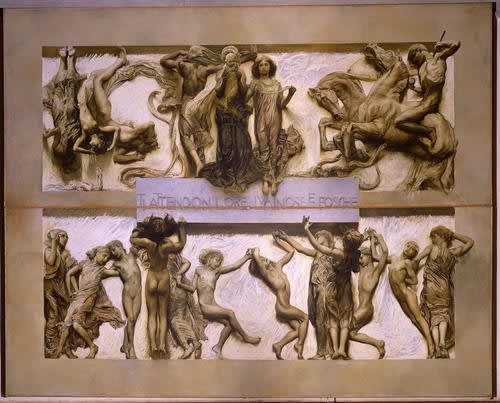
Giulio Aristide Sartorio, The light, 1907, from The Poem, of human life, a pictorial cycle for the Venice Biennale, Fondazione Musei civici, Venice

Giulio Aristide Sartorio, Frieze for Montecitorio, (detail), 1912
Notes
- Ugo Ojetti, L’arte all’esposizione di Milano. Note e impressioni, Fratelli Treves editori, Milan 1906, p. 46
- Giulio Aristide Sartorio pittore animalista, edizioni d’arte E. Celanza, Turin 1914, p. 15
- Ibid., p. 16
- Ibid., pp. 13 – 14
Join the mailing list
Subscribe to our newsletter to receive all the news about exhibitions, fairs and new acquisitions!
